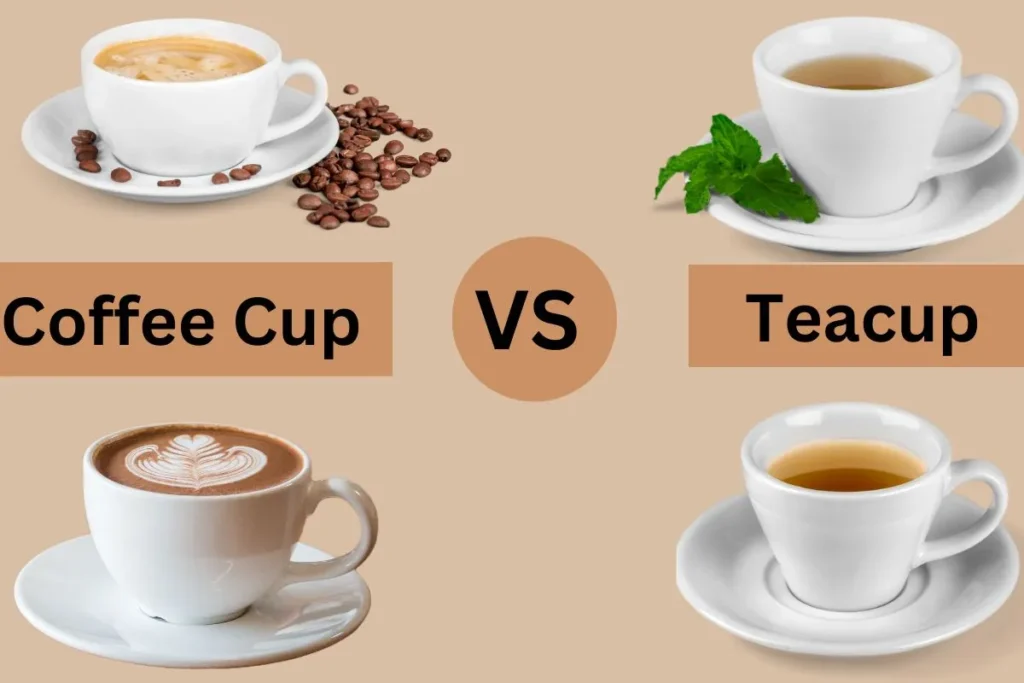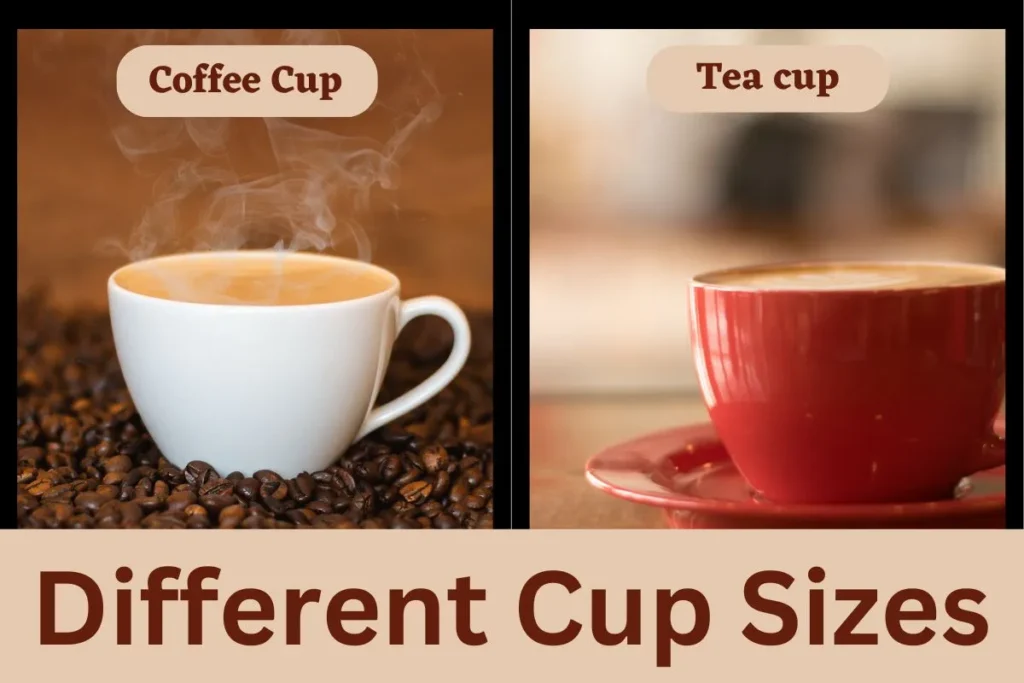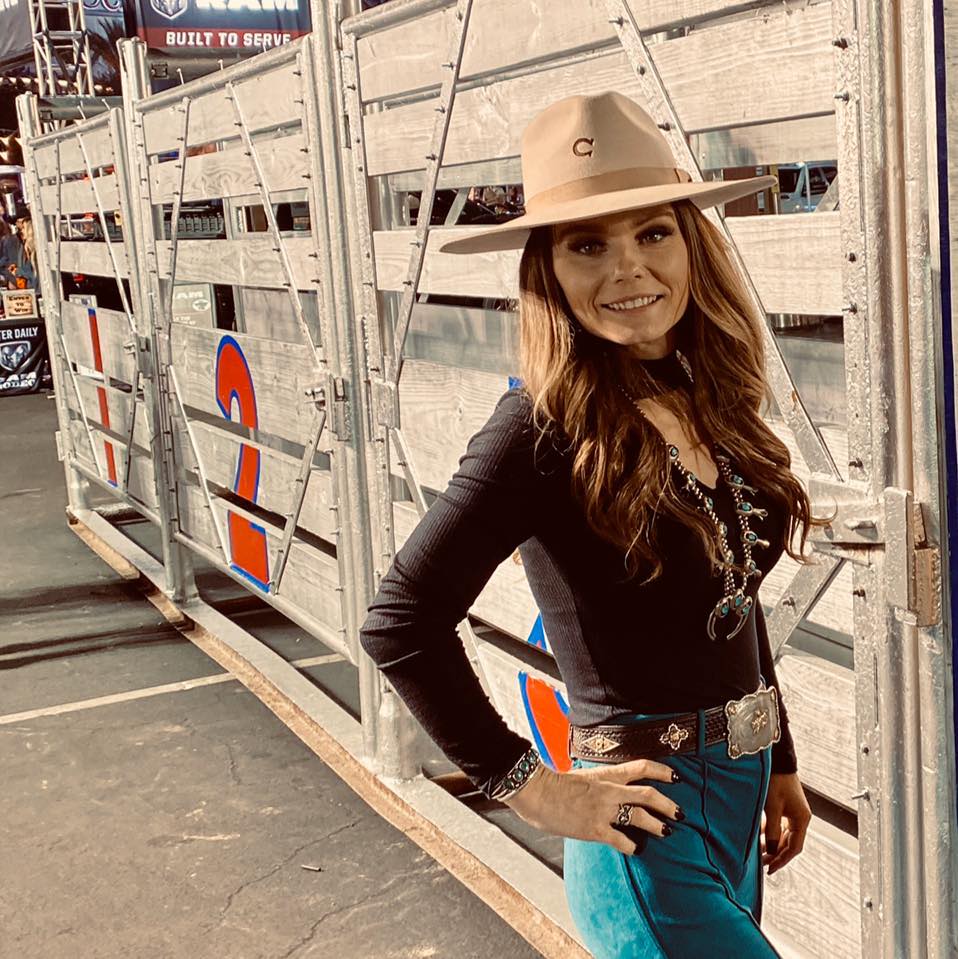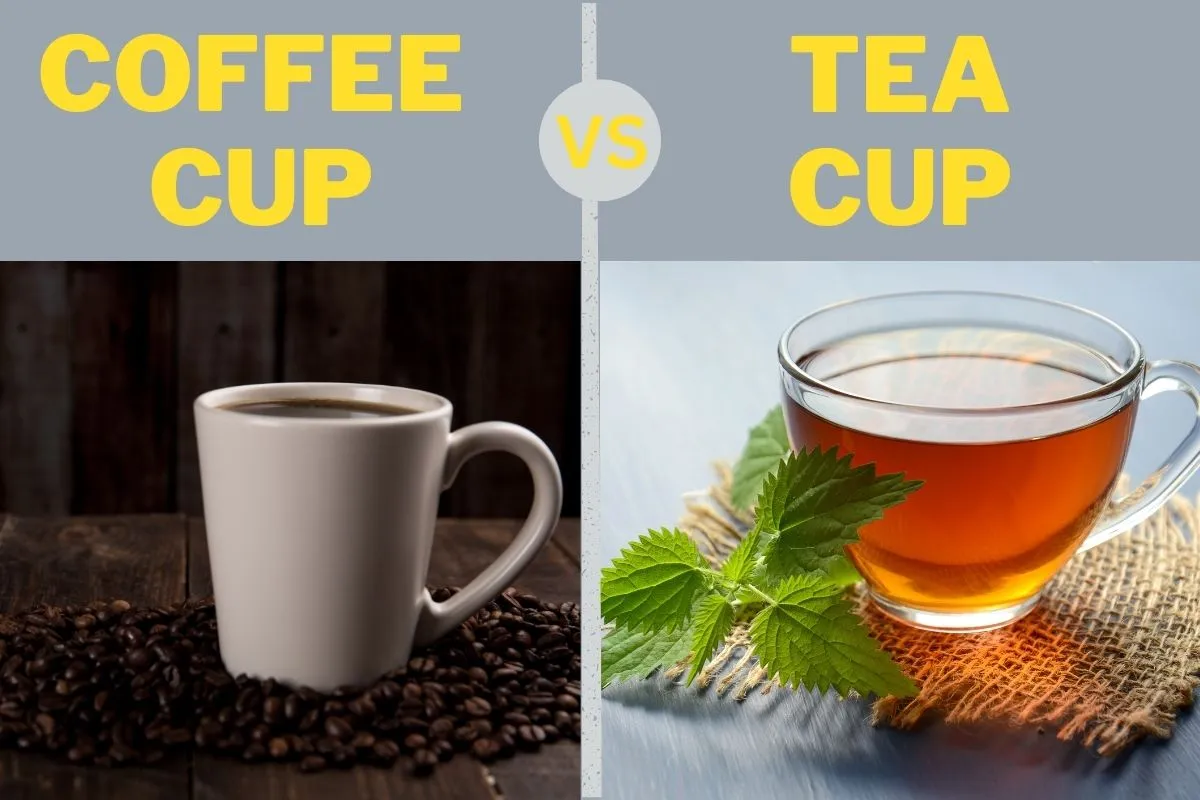Coffee and tea have long been two of the world’s most beloved hot beverages, each with its own rich history, cultural traditions, and devoted following. While both drinks are often enjoyed from a cup, there are distinct differences between the cups designed for coffee and those meant for tea.
These differences in size, shape, material, and design are not merely aesthetic choices, but rather functional elements that enhance the preparation, serving, and enjoyment of each respective beverage. Understanding the unique characteristics of coffee cups and tea cups can deepen one’s appreciation for these time-honored drinks and the customs surrounding them.
This article will explore the key differences between Coffee Cup vs Teacup, examining their design, history, and cultural significance. By the end, readers will have a clearer understanding of how to select and utilize the appropriate cup to elevate their coffee or tea drinking experience.
Coffee Cup vs Teacup: Beginnings and History

Coffee Cup Overview
The history of the coffee cup is closely intertwined with the spread of coffee drinking itself. While the exact origins of coffee are disputed, it is believed to have first been consumed in Ethiopia before spreading to the Middle East, particularly Yemen, by the 15th century. As coffee gained popularity in the Ottoman Empire, it gave rise to the establishment of coffeehouses, known as “kaveh kanes,” which served as important social hubs.
In these early coffeehouses, coffee was typically served in small, handleless ceramic cups called “fincan,” which were designed to be held in the palm of the hand. The absence of a handle allowed the cup to be easily stacked and stored, a practical consideration in busy coffeehouses.
As coffee drinking spread to Europe in the 17th century, the design of the coffee cup began to evolve. The first European coffeehouse opened in Venice in 1645, and by the late 1600s, coffeehouses had become popular gathering places in major cities like London and Paris. European cups began to feature handles, a development that some attribute to the desire to avoid burning one’s fingers on the hot ceramic.
Over time, the materials used to make coffee cups also expanded. While early cups were primarily made of ceramic, advancements in glassmaking and porcelain production in the 18th century led to the development of more refined and decorative cups. The invention of bone china by English potter Josiah Spode in the late 18th century marked a significant milestone, as this durable and elegant material became a popular choice for coffee cups among the upper classes.
In the 20th century, the rise of café culture and the increasing popularity of coffee drinks like espresso and cappuccino gave birth to a wide array of specialized coffee cup designs. From the small, thick-walled demitasse cups used for espresso to the large, bowl-like cups favored for lattes and cappuccinos, modern coffee cups are designed to enhance the specific characteristics of each drink.
Today, coffee cups continue to evolve, with a growing emphasis on sustainability and adaptability to on-the-go lifestyles. From insulated travel mugs to biodegradable disposable cups, the coffee cup has come a long way from its humble beginnings in the coffeehouses of the Ottoman Empire.
Teacup Overview
The history of the teacup is intimately tied to the history of tea consumption, which originated in ancient China. According to legend, tea was first discovered by Chinese Emperor Shen Nung in 2737 BCE when a leaf from a nearby tea tree fell into his cup of boiling water. As tea drinking became more widespread in China during the Tang Dynasty (618-907 CE), the first known teacups, known as “tenmoku,” were developed. These early cups were typically made of ceramic and featured a dark glaze.
During the Song Dynasty (960-1279 CE), tea drinking evolved into a more formalized ritual, and the design of teacups changed accordingly. The most popular style of cup during this period was the “Jian Zhan,” a small, shallow cup with a thick rim and a subtle glaze that enhanced the color and aroma of the tea. These cups were highly prized for their ability to bring out the best qualities of the tea.
As tea drinking spread to other parts of Asia, new styles of teacups emerged. In Japan, for example, the “chawan,” a wide-brimmed, handleless cup, became the preferred vessel for drinking matcha during the traditional tea ceremony. These cups were often handcrafted by skilled artisans and were valued for their rustic, asymmetrical beauty.
Tea was introduced to Europe in the early 17th century, initially as a medicinal beverage. As tea drinking became more fashionable among the European aristocracy, the demand for elegant, high-quality teacups grew. European manufacturers began producing their own teacups, often made of delicate porcelain and decorated with intricate designs and gold leaf.
In the early 18th century, the German city of Meissen became renowned for its production of high-quality porcelain teacups. Around the same time, English potters began experimenting with new materials and glazes, leading to the development of bone china teacups, which were known for their translucence, strength, and chip-resistance.
The Victorian era (1837-1901) saw a surge in the popularity of afternoon tea, a social ritual that required a wide array of specialized teacups and saucers. Many of the classic teacup designs associated with British tea culture, such as the Royal Albert “Old Country Roses” pattern, originated during this period.
In the 20th and 21st centuries, teacup design has continued to evolve, with a growing emphasis on functionality, simplicity, and adaptability to modern lifestyles. However, traditional styles remain popular, particularly in formal settings and among collectors. Today, antique and vintage teacups are highly sought after, with rare pieces commanding high prices at auction.
From the early tenmoku cups of ancient China to the delicate bone china cups of Victorian England, the teacup has undergone a fascinating evolution that reflects the changing tastes, traditions, and social customs of tea drinkers around the world.
Coffee Cup vs Teacup

| Aspect | Coffee Cup | Teacup |
| Size | Generally larger, ranging from 8 to 16 fluid ounces | Smaller, typically holding 6 to 8 fluid ounces |
| Shape | Wider and shorter | Narrower and taller |
| Material | Often made from ceramic, porcelain, or glass | Commonly crafted from fine china or porcelain |
| Handle Design | Large and sturdy | Small and delicate |
| Usage | Ideal for casual drinking and larger servings | Associated with formal tea ceremonies and smaller servings |
| Cultural Significance | Popular in Western coffee culture | Symbolic of Eastern tea ceremonies and hospitality |
| Presentation | Bold colors and playful designs | Elegant patterns and intricate detailing |
| Heat Retention | Thick walls provide good heat retention | Thinner walls may cool more quickly |
| Price Range | Wide range of prices depending on material and design | Prices vary based on craftsmanship and brand |
Design and Purpose
While both coffee cups and teacups serve the basic function of holding a hot beverage, their designs are tailored to suit the unique characteristics and serving traditions of their respective drinks.
Coffee cups are designed with the primary goal of keeping the beverage hot for an
extended period. This is achieved through several design elements:
- Thick walls: Coffee cups often have thicker walls compared to teacups, which provide better insulation and help maintain the coffee’s temperature.
- Narrow, cylindrical shape: The tall, narrow shape of a coffee cup minimizes the surface area exposed to the air, reducing heat loss.
- Large handles: Coffee cups typically feature larger, more substantial handles that allow a firm grip and insulate the hand from the cup’s heat.
- Variety of sizes: Coffee cups come in a range of sizes to accommodate different serving preferences, from small espresso cups to large mugs for cappuccinos or lattes.
Teacups, on the other hand, are designed to promote the optimal enjoyment of tea and the overall tea-drinking experience:
- Wide, shallow bowls: Teacups often have wider, shallower bowls compared to coffee cups. This design allows the tea to cool more quickly to a comfortable drinking temperature and enhances the aroma of the tea.
- Thin walls: Teacups typically have thinner walls than coffee cups, which allows the tea to cool faster and makes the cup more pleasant to hold.
- Small, delicate handles: The small, elegant handles on teacups are designed for a light grip, usually with just the thumb and one or two fingers. This design complements the graceful, refined nature of tea drinking.
- Accompanying saucers: Teacups are often served with matching saucers, which catch any spills and provide a place to rest the cup between sips. Saucers also play a role in the visual presentation of the tea service.
Materials: Coffee Cup vs Teacup
The materials used to craft coffee cups and teacups play a significant role in their functionality, durability, and aesthetic appeal. While there is some overlap in materials, each type of cup has certain materials that are more commonly associated with it due to their unique properties.
Coffee Cup Materials
Ceramic:
Ceramic is a popular choice for coffee cups due to its durability, heat retention, and versatility. Ceramic cups can be glazed in various colors and patterns, making them suitable for a wide range of design preferences.
Stoneware:
Stoneware is a type of ceramic that is fired at a high temperature, resulting in a dense, strong, and chip-resistant material. Stoneware cups are ideal for everyday use and are often found in casual dining settings.
Porcelain:
Porcelain is a more refined and elegant ceramic material that is known for its translucence and delicate appearance. However, it is also more brittle and prone to chipping compared to other ceramics.
Glass:
Glass coffee cups, particularly double-walled or insulated varieties, have gained popularity in recent years. They offer a modern, sleek appearance and allow the drinker to appreciate the visual layering of coffee drinks like lattes and cappuccinos.
Stainless Steel:
Stainless steel is commonly used for travel coffee mugs and to-go cups due to its durability, light weight, and heat retention properties. However, it is less common for in-home use.
Teacup Materials
Porcelain:
Porcelain is the most popular material for teacups, particularly in formal or traditional settings. Its delicate appearance, translucence, and light weight make it well-suited to the elegance and refinement associated with tea drinking.
Bone China:
Bone china is a type of porcelain that includes ash from animal bones in its composition. This addition makes bone china even more translucent, lightweight, and strong compared to regular porcelain. It is often considered the highest quality material for teacups.
Ceramic:
While less common than porcelain, ceramic teacups are still used, particularly in more casual settings. They offer greater durability and heat retention compared to porcelain.
Glass:
Glass teacups, while less traditional, have become more popular in recent years. They are particularly favored for blooming teas or other visually appealing tea varieties, as the transparency allows the drinker to appreciate the colors and shapes of the tea leaves.
Stoneware:
Stoneware teacups, particularly in Asian tea traditions like Japanese tea ceremonies, are valued for their rustic, handcrafted appearance and ability to retain heat.
Thermal Properties
The thermal properties of coffee cups and teacups are essential considerations, as they directly impact the enjoyment and quality of the beverages they hold. The materials used in the construction of these cups play a significant role in their ability to retain heat, influence the drinking temperature, and maintain the desired taste profiles of coffee and tea.
Coffee Cups:
Coffee is typically served at a higher temperature than tea, around 160-185°F (71-85°C), and is meant to be consumed slowly over a longer period. As a result, coffee cups are designed to retain heat more effectively.
Thick walls:
The thicker walls of ceramic, stoneware, or porcelain coffee cups provide better insulation, slowing down heat loss and keeping the coffee hot for longer.
Narrow, cylindrical shape:
The tall, narrow shape of a coffee cup minimizes the surface area exposed to the air, which reduces heat dissipation.
Insulated materials:
Some coffee cups, particularly travel mugs, are made with double walls or vacuum insulation to minimize heat transfer and maintain the coffee’s temperature for extended periods.
Heat retention:
Materials like ceramic and stoneware have a higher heat capacity than glass or metal, meaning they can store more heat energy and release it slowly over time.
Teacups:
Tea is generally brewed at a higher temperature than coffee, around 175-205°F (80-96°C), but is often consumed at a slightly lower temperature to avoid scalding and to allow for the appreciation of the tea’s flavor profile.
Thin walls:
The thinner walls of porcelain or bone china teacups allow the tea to cool more quickly to a comfortable drinking temperature. This is particularly important for delicate teas that can be adversely affected by prolonged exposure to high temperatures.
Wide, shallow shape:
The broader surface area of a teacup allows for faster heat dissipation, bringing the tea to a suitable drinking temperature more quickly.
Heat conductivity:
Materials like porcelain and bone china have lower heat capacities and higher thermal conductivity compared to materials like stoneware or ceramic. This means they absorb and release heat more quickly, allowing the tea to reach a drinkable temperature faster.
Handles:
The small, delicate handles on teacups serve a dual purpose – they provide a comfortable grip and help insulate the hand from the cup’s heat, allowing the tea to be enjoyed at a higher temperature if desired.
Size and Shape
The size and shape of coffee cups and teacups are not merely aesthetic choices but are designed to enhance the specific characteristics and serving traditions of each beverage.
Coffee Cups
Capacity:
Coffee cups generally have a larger capacity compared to teacups, typically ranging from 6 to 20 ounces (180 to 590 ml). This allows for the serving of larger coffee drinks, such as lattes, cappuccinos, and Americanos.
Height and width:
Coffee cups are usually taller and narrower than teacups. This shape helps to retain heat by minimizing the surface area exposed to the air, keeping the coffee hot for longer.
Variations:
Coffee cups come in a variety of sizes and shapes depending on the type of coffee being served. For example:
- Espresso cups (demitasse): These are small, typically holding 2-3 ounces (60-90 ml), and are used for serving concentrated espresso shots.
- Cappuccino cups: These are slightly larger than espresso cups, usually holding 5-6 ounces (150-180 ml), and are designed to accommodate a shot of espresso and a layer of steamed milk and foam.
- Latte cups: These are larger still, holding 10-16 ounces (300-475 ml), and are used for serving lattes, which have a higher ratio of steamed milk to espresso.
- Rim: Coffee cups often have a narrower rim compared to teacups, which helps to concentrate the aroma of the coffee and enhance the drinking experience.
Teacups
Capacity:
Teacups generally have a smaller capacity compared to coffee cups, typically holding 5-8 ounces (150-240 ml). This is because tea is often served in smaller portions and is meant to be sipped rather than consumed quickly.
Height and width:
Teacups are usually shorter and wider than coffee cups. The wider brim allows for faster cooling of the tea to a comfortable drinking temperature and enhances the aroma of the tea.
Variations:
Like coffee cups, teacups also come in various sizes and shapes depending on the type of tea and the serving tradition. For example:
- English teacups: These are typically small, holding 4-6 ounces (120-180 ml), and are used for serving traditional English tea blends.
- Asian teacups: In Chinese and Japanese tea traditions, smaller cups are often used, sometimes holding as little as 1-2 ounces (30-60 ml). These cups are designed for the appreciation of delicate, high-quality teas and are often used in formal tea ceremonies.
- Mughal teacups: In Indian and Middle Eastern tea traditions, larger teacups or small glass tumblers are common, as tea is often served with milk and spices and is meant to be consumed in larger quantities.
- Saucer: Teacups are usually accompanied by a saucer, which serves as a resting place for the cup between sips and catches any spills. The saucer also plays a role in the visual presentation of the tea service.
Presentation
The presentation of coffee and tea plays a significant role in the overall drinking experience, and the choice of cup is an essential aspect of this presentation. The way in which coffee cups and teacups are designed, decorated, and paired with other serving pieces reflects the cultural traditions, social customs, and aesthetic preferences associated with each beverage.
Coffee Cup Presentation
Saucers:
While coffee cups are sometimes served with saucers, particularly in more formal settings or when serving espresso, they are not as essential to the presentation as they are for teacups. When used, coffee cup saucers are typically larger and more utilitarian in design compared to those used for tea.
Spoons:
Coffee cups are often served with a small spoon for stirring in sugar, cream, or other additives. These spoons are usually simple in design and may be made of stainless steel or other durable materials.
Decorative elements:
Coffee cups can feature a wide range of decorative elements, from simple solid colors to intricate patterns, logos, or artistic designs. These designs often reflect the branding of a particular coffee shop or the personal style of the drinker.
Serving accessories:
In addition to cups and saucers, coffee service may include other accessories such as sugar bowls, creamers, and biscotti or cookie plates. These items are often chosen to complement the style of the coffee cups and create a cohesive visual presentation.
Teacup Presentation
Saucers:
Teacups are almost always served with matching saucers, which play a crucial role in the presentation and functionality of the tea service. The saucer provides a stable resting place for the cup, catches any spills, and helps to cool the tea by allowing the drinker to pour a small amount from the cup onto the saucer.
Spoons:
Teacups are typically served with small, delicate spoons that are designed to match the style and material of the cup. These spoons may be used for stirring in sugar or other additives, or for gently scooping loose tea leaves from the bottom of the cup.
Decorative elements:
Teacups are often highly decorative, with intricate patterns, colors, and designs that reflect the cultural traditions and aesthetic preferences associated with tea drinking. Many teacups feature floral motifs, gold or silver accents, or other embellishments that contribute to their visual appeal and collectibility.
Serving accessories:
Tea service often involves an array of specialized accessories, including teapots, tea strainers, sugar bowls, creamers, and even small plates for lemon slices or sweet accompaniments. These items are typically chosen to match or complement the style of the teacups and create an elegant, cohesive presentation.
Price Range
The price range for coffee cups and teacups can vary widely depending on factors such as material, brand, design, craftsmanship, and rarity. While it is possible to find affordable options for both types of cups, there are also high-end, luxury versions that can command significant prices.
Coffee Cups
Budget options:
Simple, mass-produced ceramic or stoneware coffee cups can be found at very affordable prices, often costing just a few dollars each. These cups are typically plain in design and may not have the same durability or heat retention properties as higher-end options.
Mid-range options:
Coffee cups made from higher-quality materials like porcelain or borosilicate glass, or those with more intricate designs, can cost anywhere from $10 to $50 each. These cups often offer better heat retention, durability, and aesthetic appeal compared to budget options.
High-end options:
Luxury coffee cups made from premium materials like bone china, hand-blown glass, or those featuring intricate hand-painted designs or precious metal accents can cost $50 or more per cup. These cups are often considered collectibles or status symbols and may be produced by renowned manufacturers or designers.
Teacups
Budget options:
Like coffee cups, simple, mass-produced teacups made from ceramic or stoneware can be found at very affordable prices, often costing just a few dollars each. These cups may not have the same delicacy, translucence, or decorative appeal as higher-end options.
Mid-range options:
Teacups made from higher-quality materials like fine porcelain or bone china, or those with more intricate designs and patterns, can cost anywhere from $20 to $100 each. These cups often offer better durability, heat conductivity, and aesthetic appeal compared to budget options.
High-end options:
Luxury teacups made from premium bone china, hand-painted porcelain, or those produced by renowned manufacturers like Royal Albert, Wedgwood, or Limoges can cost hundreds or even thousands of dollars per cup. Antique or rare teacups, particularly those from sought-after collections or historical periods, can also command very high prices among collectors.
Regional Variations
The design, materials, and usage of coffee cups and teacups can vary significantly across different regions and cultures, reflecting the unique histories, traditions, and preferences of each area.
Coffee Cup Regional Variations
Turkish coffee cups:
In Turkey and other parts of the Middle East, coffee is traditionally served in small, handleless cups called “fincan.” These cups are typically made of porcelain or ceramic and are designed to be held in the palm of the hand.
Italian espresso cups:
In Italy, espresso is served in small, thick-walled ceramic cups called “tazzina.” These cups are designed to retain heat and concentrate the aroma and flavor of the espresso.
Vietnamese coffee cups:
In Vietnam, coffee is often served in small, clear glass cups with a layer of sweetened condensed milk at the bottom. The coffee is brewed directly into the cup using a metal drip filter called a “phin.”
American diner mugs:
In American diners and cafes, coffee is often served in large, heavy ceramic mugs. These mugs are designed for durability and heat retention and often feature simple, classic designs.
Teacup Regional Variations
Chinese tea cups:
In China, tea is traditionally served in small, handleless cups called “pinming bei” or “tea tasting cups.” These cups are typically made of porcelain or glass and are designed to showcase the color and aroma of the tea.
Japanese tea bowls:
In the Japanese tea ceremony, tea is served in wide, shallow bowls called “chawan.” These bowls are often handcrafted from ceramic or stoneware and feature unique glazes and designs that reflect the aesthetics of the tea ceremony.
Russian tea glasses:
In Russia, tea is often served in small, clear glass cups called “stakan.” These cups are typically held in ornate metal holders called “podstakannik,” which help to insulate the hand from the heat of the glass.
British tea cups:
In Britain, tea is traditionally served in fine bone china cups with matching saucers. These cups often feature intricate floral designs or patterns and are accompanied by small tea spoons and other serving accessories.
Moroccan tea glasses:
In Morocco, tea is often served in small, ornate glass cups called “keesan.” These cups are typically adorned with colorful patterns or metallic accents and are designed to showcase the clarity and color of the tea.
Modern Variations and Exceptions
While traditional coffee cups and teacups have distinct characteristics, modern variations and exceptions have blurred the lines between these two types of drinkware. As coffee and tea culture continues to evolve, new designs and materials have emerged that challenge conventional notions of what constitutes a coffee cup or teacup.
Modern Coffee Cup Variations and Exceptions
Travel mugs:
With the increasing popularity of on-the-go coffee consumption, travel mugs have become a common alternative to traditional coffee cups. These mugs are typically made of insulated stainless steel or plastic and feature leak-proof lids to prevent spills.
Cappuccino and latte cups:
Many modern coffee shops serve cappuccinos and lattes in wide, shallow cups that resemble bowl-like teacups. These cups provide ample space for latte art and allow the drinker to appreciate the layering of espresso, steamed milk, and foam.
Glass coffee cups:
Some specialty coffee shops have begun serving coffee in clear glass cups, allowing customers to appreciate the color and consistency of the brew. These cups often have double walls for insulation and can be used for both hot and iced coffee.
Disposable cups:
While not a variation on traditional coffee cups per se, disposable cups have become a ubiquitous part of modern coffee culture. These cups are typically made of paper or plastic and are designed for single use, reflecting the fast-paced, on-the-go nature of contemporary life.
Modern Teacup Variations and Exceptions
Oversized teacups:
Some modern teacup designs feature larger capacities than traditional cups, accommodating the preferences of tea drinkers who enjoy longer steeping times or larger servings. These cups often have a more substantial feel and may be made of thicker ceramic or stoneware.
Glass tea cups:
Like their coffee counterparts, glass teacups have gained popularity in recent years. These cups are particularly well-suited for blooming teas or other visually appealing tea varieties, as they allow the drinker to appreciate the unfurling of tea leaves or the color of the brew.
Travel tea infusers:
For tea drinkers who prefer loose leaf tea on the go, travel tea infusers have become a popular alternative to traditional teacups. These infusers typically consist of a large mug with a built-in strainer or filter, allowing the tea to be brewed directly in the cup.
Teacup-style coffee mugs:
Some modern coffee mugs have adopted design elements from traditional teacups, such as floral patterns, delicate handles, or accompanying saucers. These mugs blur the line between coffee and tea drinkware and reflect the increasing crossover between these two beverage cultures.
Conclusion
In the age-old debate of coffee cup vs. teacup, there is no one-size-fits-all answer. Each vessel offers its own unique blend of style, functionality, and cultural significance, catering to the diverse tastes and preferences of coffee and tea enthusiasts around the world.
Whether you prefer the robust flavor of coffee or the delicate aroma of tea, choosing the right cup can enhance your drinking experience and elevate the ritual of sipping your favorite brew.
FAQs
Q1: What is the difference between a tea cup and a coffee cup?
Tea cups and coffee cups differ in their size, shape, material, and handle design. Tea cups are smaller with a rounded shape and wider rim to allow the hot tea to cool quickly. They often have a delicate, single-finger handle. Coffee cups tend to be larger and taller with a cylindrical shape to retain heat better. Coffee cup handles are designed for a sturdier, multi-finger grip.
Q2: Are tea cups and coffee cups made of the same material?
No, tea cups are typically made of finer materials like bone china, porcelain, or glass to allow for quicker cooling of the tea. Coffee cups often use thicker, more insulating materials like stoneware or ceramic to keep the coffee hotter for longer. Some tea cups may also have a translucent appearance that coffee cups rarely have.
Q3: Do tea cups always come with saucers?
Yes, tea cups almost always come with a matching saucer that is small and decorative. Coffee cups may or may not include a saucer, and if included, the saucer is larger and more utilitarian.
Q4: Can I use a coffee cup for tea or vice versa?
While you can use any cup for any beverage, tea cups and coffee cups are designed specifically to optimize the drinking experience for their respective beverages in terms of temperature, aroma, elegance, and other factors. Using the intended cup provides the best experience.
Q5: What sizes do tea cups and coffee cups come in?
Tea cup sizes typically range from 5-8 oz while coffee cup sizes can range from 6-20 oz or more to accommodate different coffee drink styles like cappuccinos, lattes, etc. In general, coffee cups have a wider range of larger size options compared to smaller, daintier tea cups.

Rossi Glover, the passionate Owner of Grand Lake Coffee, infuses every cup with her love for coffee and dedication to quality. With an extensive background in the art and science of coffee, Rossi is not just a connoisseur but a storyteller, sharing the intricate tales behind each brew.

